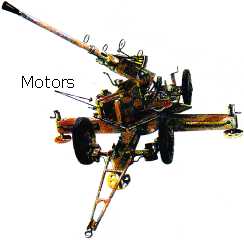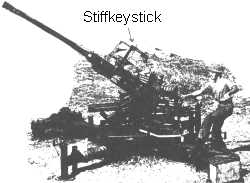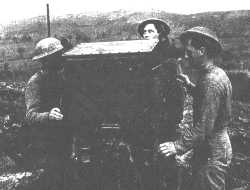|
QF 40-mm Anti-Aircraft Gun (The Bofors) | |||||||||||||||
|
By 1920 some reasonably efficient anti-aircraft guns had been produced, notably the British QE 3-inch 20-cwt adopted in 1913, which could adequately deal with enemy aircraft of the times. However, during the 1920s improvements in the performance of aircraft prompted the British Army to take another hard look at air defence. In 1928 they proposed the QF 3.7-inch AA gun to replace the 3-inch 20-cwt, and the former eventually went into production in 1937. It was well able to cope with the 'ceilings' achieved by heavy aircraft at that time. | |||||||||||||||
|
At the same time they realised the necessity of dealing with low-flying planes and decided during the 1930s to adopt the Naval twin 2-pr 'pom-pom' and ordered 60 of them. But the 2-pr was a cumbersome equipment, suitable only for fixed defences. A mobile gun was needed which led Army to adopt the Swedish Bofors QF 40-mm equipment of which 100 were ordered identical to the 1926 model shown in Fig. 1. At the same tine manufacture of the 2-pr 'pom-pom' ceased. Commonly called 'the Bofors' the gun in Fig. 1 was first produced in 1936. It was also manufactured under licence by Austria, Belgium, Finland, France, Hungary, Italy, Norway. Poland, and the United Kingdom - or merely copied by almost every other country capable of armament manufacture. During world War 2 Canada, the United States, and the UK produced the gun on a mobile platform which was cheaper and easier to make. Unlike the earlier equipment wheels and axles were removed when the gun went into action.
|

Fig. 1 QF 40-mm AA gun on original mobile platform. | ||||||||||||||
|
Although both equipments could be fired while resting on their wheels they were of course much more stable when resting on their jacks as shown in Figs 1 and 2. | |||||||||||||||
BreechThe breech which consists of a closed-jaw breech ring with a vertically sliding block is recoil-operated. It can be set to 'single shot' or 'automatic'. Cartridges are loaded in clips of four into the auto-loader as shown in both Figs 1 and 2, while the empty cases are ejected down a chute to the front. The gun is fired by foot-pedal. |

Fig. 2 QF 40-mm AA gun on modified World War 2 platform | ||||||||||||||
SightingAt first sights were as illustrated in Fig. 1. i.e. rings with radial bars to assist the layers in applying the necessary amounts of aim-off and elevation to allow for the range and approach angle of the target. In 1944 the 'stiffkey Stick' was introduced as shown in Fig. 2. With this a third layer stood on the firing platform and by means of an adjusting mechanism applied approach angle and elevation to the sights of the respective layers simultaneously. This meant the layers had only to align the centres of their sights on the target and made for greater efficiency in its engagement. AmmunitionShells were fitted with direct-action fuzes, i.e. designed to detonate on impact. To assist in observation they were also fitted with tracers designed to burn through and detonate the fuze if the shell failed to hit the target. This prevented the spent shell falling to earth and possibly injuring men on the ground. A proportion of armour-piercing shot were also provided in case ground targets were encountered. | |||||||||||||||
Predictor ControlA predictor, an example of which is shown in Fig. 3, was a computer. It was so-called because when it was made to follow a target it took into account the target's course and speed as well as the projectile's direction and velocity with the object of predicting a future position where the two would meet. The necessary information, bearing and elevation, was fed to the gun via two motors seen either side of the firing platform in Fig. 1, i.e layers were not required. Solid-state electronic components were unknown during World War 2 which accounts for the size of the predictor; computing components were largely of a bulky mechanical nature. As predictor-control required the setting-up of a heavy generator as well as the alignment of the guns to coincide with that of the predictor, it was preferred mainly for static positions. On mobile operations open sights were mainly used. |

Fig. 3 40-mm Predictor manned by Kiwis in Italy 1944 | ||||||||||||||
|
During the reorganisation of 1962 the anti-aircraft regiments in New Zealand were disbanded, and the 40-mm guns given to the RNZ Navy who converted them for shipboard use by removing their mobile platforms. Thus apparently there no longer exists even one mobile version at the Army Museum. The Navy made a saluting battery from four of the guns by shortening the barrels, removing the auto-loading gear, and converting the guns to fire 'single-shot'. They did not look very impressive but made the necessary amount of noise!
General Data
WL Ruffell
Guns at Waiouru | Guns around New Zealand | More equipments | Home | |||||||||||||||